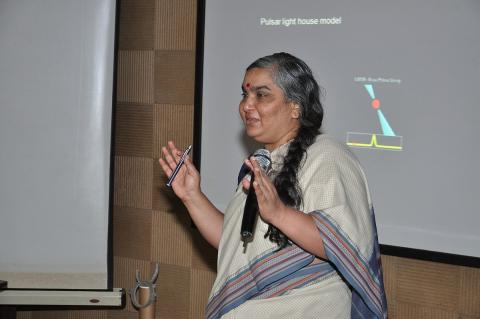
The Astronomical Society of India deeply mourns the tragic demise of Dr. Nandivada Rathnasree. An avid Astronomy communicator and accomplished pulsar astronomer, she was pivotal in most astronomy outreach projects of ASI in the last two decades. When ASI formally set up its Public Outreach and Education Committee (POEC) in 2014, Rathnasree was the unanimous choice to be its first chair and she has been a part of the POEC ever since.
Rathnasree was a graduate student in the Theoretical Astrophysics Group at TIFR, Mumbai, in late 1980s and early 1990s, where she worked in the area of Stellar Evolution and Population synthesis with Prof. Alak Ray. As a postdoctoral fellow at the University of Vermont, Burlington, USA (1992-1994), she worked with Prof. Joanna Rankin and carried out pulsar observations using the Arecibo radio-telescope. Soon she moved to RRI, Bengaluru (1994 1996), as a postdoctoral fellow. During her doctoral years, her focus remained primarily on massive binaries, particularly in the Large Magellanic Cloud. During her postdoctoral years, Rathnasree incisively probed a range of aspects manifested in the pulsar radio emission and associated polarisation properties. Her works on the approach to stability of pulsar average profile, mode separations and emission geometry of a few select pulsars provide timeless guidance to youngsters and experienced alike.
In 1996, she moved to Delhi and joined the Nehru planetarium as Senior Planetarium Educator and became its director in 1999. For the last 21 years, she was not just the standard bearer for astronomy outreach in the national capital region but also an inspirational figure to astronomy communicators around the country.
At Nehru Planetarium she started several new activities. Under her leadership, the Planetarium became the go to place for UG and PG students around Delhi to do short astronomy research projects. She was the focal point for the amateur astronomy community in and around Delhi and guided them on all kinds of things from the photometric observations of stars to new techniques for astrophotography. She is remembered fondly by all students who benefited from her infectious enthusiasm, her humility, gentleness, kindness, her enormous capacity for work and her ability to excite the youth.
One of her important contributions was her efforts towards preservation of Jantar Mantar observatories of Raja Sawai Jai Singh and her work with students to make the astronomy behind these gigantic instruments accessible to the common public. What started as a simple positional astronomy project with a group of students evolved into cleaning and restoration of some of the Jantar mantar Instruments, posters, leaflets and student activity sheets to explain the working of these instruments and programmes to train tour guides at Delhi as well as Jaipur. She also wrote numerous scholarly articles and books about the mathematics behind these instruments and shared her knowledge in various international conferences. Recognising her expertise, Archeological Survey of India had appointed her on the committee overseeing restoration of Jantar Mantar in Delhi.
Rathnasree worked with the National Council of Science Museums to advise them on astronomy related exhibits and activities at various science centres. She was also the chief editor for class VI textbooks for NCERT. She was the primary astronomy expert for all journalists around the capital for any astronomy related events and she was always eager to explain astronomy to them in as simple a manner as possible.
In 2018-19, on account of Mahatma Gandhi’s 150th birth anniversary, she ran an year long campaign titled ‘Bapu Khagol Mela’, where she and her team visited many of the locations where Mahatma Gandhi lived during his life and conducted astronomy outreach programmes at each of those locations. Even during the pandemic times she was actively conducting online lectures, workshops and discussion sessions to keep the outreach going. In December 2020, she led POEC’s ‘Samanta Chandrasekhar Challenge’ at the time of the great conjunction of Saturn and Jupiter, where students were encouraged to make their own cross staffs and measure angular separation between the planets.
Till just a fortnight ago, she was involved in organising ‘Astro Adda’ a fortnightly online discussion session with the students. In early May, she caught the COVID-19 infection, which quickly overwhelmed her.
She is survived by her husband Prof. Patrick Dasgupta, who is a faculty member of Department of Physics and Astrophysics at Delhi University, son, daughter in law and a granddaughter.
